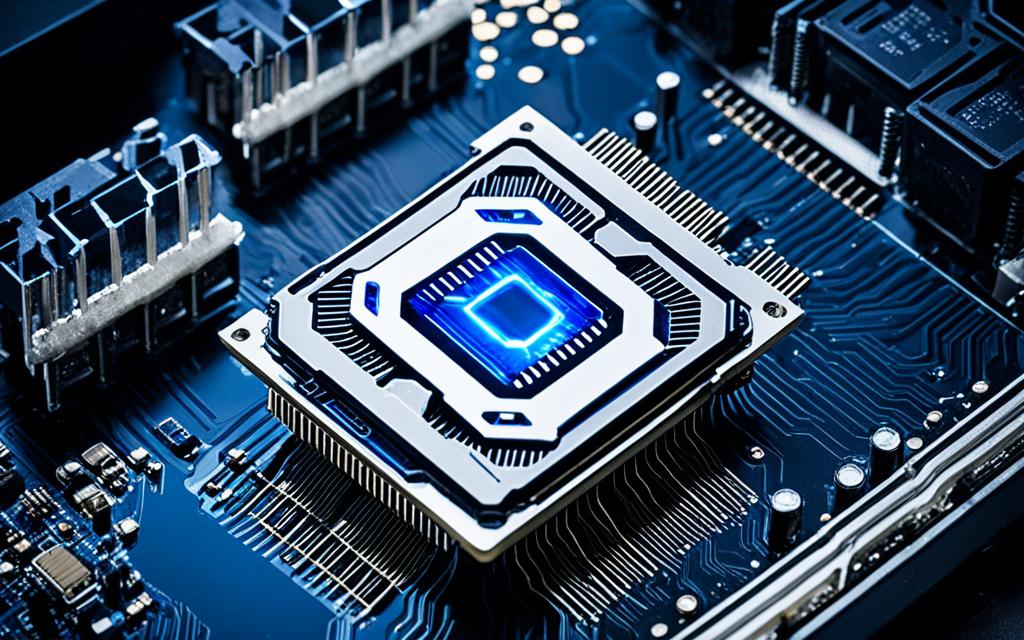Table of Contents
It’s really important to know the signs of CPU failure. A dead CPU can make your computer stop working, which hits productivity hard. Knowing these signs early helps a lot. Sometimes, if your computer doesn’t work even when it’s on, it might be your CPU’s fault. Main signs are when your computer can’t start properly, shuts down suddenly, and shows the dreaded Blue Screen of Death (BSOD)1.
These problems can really make using your computer a nightmare. That’s why it’s crucial to spot these issues early. This way, you can figure out if your CPU is dead before things get worse. We wrote this article to help you spot these early warnings of CPU failure.
Key Takeaways
- Identifying dead CPU symptoms can help in early diagnosis.
- Common signs include no POST, rapid shutdowns, and screen freezes.
- Physical signs like burn marks can indicate a malfunctioning CPU.
- Understanding beep codes can assist in diagnosing CPU issues.
- Frequent system reboots or BSOD occurrences are serious warning signs.
Understanding the Central Processing Unit (CPU)
The Central Processing Unit, or CPU, is like the computer’s brain. It deciphers and carries out instructions from various programs. To understand what is a CPU, it’s essential to know its role in handling data and managing the flow of information. If the CPU stops working, the computer will too. Knowing how the function of a CPU impacts the computer’s overall setup is key. It affects hardware compatibility, performance, and stability.
The CPU is complex and prone to overheating. This can cause it to fail. Signs of trouble include odd behaviour, sudden shutdowns, or not passing the Power-On Self Test (POST). These are warning signs not to be ignored2. Problems with the CPU can quickly harm the entire system. Therefore, getting expert help early is crucial. It helps avoid worse damage and keeps your CPU working well for longer.
Key Symptoms of a Dead CPU
Knowing the CPU symptoms that suggest a break down is key. A broken CPU shows many clear clues. Spotting these clues can mean the difference between an easy fix and expensive replacements.
Zero Functionality
If a CPU is dead, the computer won’t function at all. When the computer powers on but does nothing, it’s likely a major CPU problem. This means the essential parts aren’t getting needed signals to work.
No POST (Power-On Self Test)
A POST failure also points to CPU troubles. The Power-On Self Test checks system parts before the OS launches. If there are no beeps or signals, it might mean the CPU has failed. This stops the computer from starting properly.
Overworking Fans and Rapid Shutdowns
A faulty CPU can overwork the fans, causing them to run fast constantly. This issue is also linked with rapid shutdowns to prevent overheating. It’s important to keep an eye on the cooling system for signs of CPU problems.
https://www.youtube.com/watch?v=W4n4Wwmm7MA
How to Know If Your CPU is Dead
To find out if your CPU is dead, take a step-by-step approach. Start by looking at it closely, then check for beep sounds. Also, try it with a CPU you know works. These steps help you understand CPU diagnosis better.
Visual Inspection of the CPU
Checking your CPU closely can show clear signs of trouble like burnt or damaged pins. Any odd things you see could mean it got too hot or something else went wrong. Make sure it’s put in right and the heat paste is applied correctly.
Listening for Beep Codes
Different beep sounds when your computer starts can tell you about problems. Each beep pattern is unique and can show issues, including with the CPU. Learn these beep sounds to figure out if your CPU is the problem.
Testing with a Known Working CPU
Swapping your CPU with one you know works is a smart move. If the computer starts fine after the swap, it’s likely your original CPU has failed. This step, along with checking physically and listening for beeps, helps solve CPU issues341.
Additional Signs of CPU Failure
It’s essential to know the signs of CPU failure to keep your computer running well. Symptoms like screen freezes and the infamous Blue Screen of Death (BSOD) are early warnings. These aren’t just small problems; they are serious signals that need fast action.
Screen Freezes and Blue Screen of Death
If your system freezes a lot, it may be a sign of CPU trouble. A screen that keeps freezing during important tasks is a warning sign. Also, if you see the BSOD often, your CPU might be getting too hot, which can lead to failure5. Ignoring these warnings could make things worse, possibly making your system unusable.
Random Shutdowns and Boot Looping
Random shutdowns can be a major issue, as they might cause you to lose data. If your system shuts down on its own over and over, it could mean your CPU is failing16. Boot looping is another sign of trouble, where your computer keeps trying to start but can’t. It’s important to pay attention to these early signs to stop bigger problems.
Being proactive can help save time and money. Keep an eye on how your system is doing and watch out for these symptoms. To help keep your computer working well, check out this guide for tips on maintenance516.
Diagnosing a Dead CPU
If you think your CPU might be dead, start by spotting the symptoms. Then, use good diagnostic methods. This helps figure out if it’s really the CPU or something else. Testing the CPU can give us clues to what the problem might be.
Isolating the Issue
First up, let’s focus on CPU issues by checking the symptoms of failure. You might see a blank screen when starting up, hear odd beeps, or see your computer crash often. Overheating, fan noises, and slow running might also point to a CPU issue, especially if they keep happening7. Look over the CPU for any visible damage or if it’s not set right in its place.
Performing a Power Test
Doing a power test can help too. Look for signs that the power isn’t steady or if the CPU gets too hot. Temperatures over 90 degrees Celsius are a red flag for overheating2. Software errors that keep showing up could mean the CPU is at fault. Swapping the CPU with one that works can also help pinpoint the issue. If problems are still there, it might be time to get help from pros. Check out this link for more details on fixing issues.
The Impact of Overheating on CPU Longevity
Keeping CPUs cool is key to their longevity. Overheating can cause serious harm, reducing performance and leading to possible failure. It’s important to watch temperatures regularly. This helps ensure everything runs within safe levels.
Monitoring CPU Temperature
A good monitoring system lowers the risks of high CPU temps. CPUs should stay between 60°C when idle and 80°C when busy. Tools like HWMonitor and Core Temp provide updates in real time8. High temps over time can damage computer parts. This makes regular checks vital9. Over 80% of overheating is due to poor air flow or weak cooling8. Solving these problems with good monitoring can stop minor issues and sudden crashes.
Ensuring Adequate Cooling
A strong cooling system helps control CPU temps. Dust can block air flow and raise temperatures9. Cleaning your computer well twice yearly keeps it running smoothly9. For intense tasks, liquid cooling systems are best. They remove heat more effectively than fans10. Though more expensive, upgrading to liquid cooling offers better performance for heavy demands8. So, proper cooling is crucial for CPU health and reliability.
Conclusion
It’s critical to know the symptoms of a failing CPU and act quickly. Staying informed about the central processing unit and its failure signs is important. These signs can include overheating, slower performance, and annoying error messages. By using good troubleshooting techniques and looking up dead CPU fixes, you can prevent a lot of data loss. You also avoid the hassle of your equipment being out of action for too long.
To stop your CPU from failing, keeping it cool is key. Make sure to check its temperature regularly. It’s also wise to look for any physical damage, like burnt parts or capacitors that look swollen. Following tips from experts about checking your power supply and motherboard connections can help too. This helps in spotting issues early and keeps your computer running well.
Being careful about how you use and look after your CPU can make it last longer and work better. If you notice problems, getting help from a pro can save you time and money. It makes sure your computer stays working for longer. For more tips on finding CPU issues, you can read more here11.
FAQ
What are the common symptoms of a dead CPU?
A dead CPU might make your computer do nothing at all. It might fail to start up or shut down quickly. You could also see the system freeze or get the Blue Screen of Death often. These signs can mess up how your computer works.
How can I determine if my CPU is indeed dead?
Check your CPU for any visible damage to see if it’s dead. Listen for error beeps from the motherboard when it’s on. Also, try using a working CPU to see if your system starts up properly.
What does POST failure indicate?
A POST failure usually means there’s a big hardware issue, maybe with the CPU. If your computer can’t start POST, it suggests the CPU might not be working right. This means it can’t start up the other parts.
What should I do if I experience the Blue Screen of Death (BSOD)?
Seeing the BSOD a lot could mean problems with your CPU, driver conflicts, or memory issues. Check your computer for any hardware problems. Make sure your drivers are current. Run tests to find the specific issue.
How important is cooling for CPU health?
Keeping your CPU cool is very important for its health. If it gets too hot, it might not work well or could even break. Always watch the CPU temperature. Make sure your cooling systems work well to keep performance at its best.
Source Links
- https://gadgetmates.com/how-to-know-if-your-cpu-is-dead-quick-easy-test – How To Know If Your CPU Is Dead? Quick & Easy Test – GadgetMates
- https://ms.codes/blogs/computer-hardware/how-to-know-if-your-cpu-is-dead – How To Know If Your CPU Is Dead
- https://community.spiceworks.com/t/how-do-you-confirm-a-cpu-is-dead/193460 – How do you confirm a CPU is DEAD!???
- https://apexgamingpcs.com/blogs/apex-support/how-to-tell-if-cpu-is-bad – How to Tell if Your CPU is Bad With Fixes
- https://softwareg.com.au/blogs/computer-hardware/how-to-know-if-your-cpu-is-dead – How To Know If Your CPU Is Dead
- https://www.pcguide.com/cpu/how-to/tell-is-failing-or-dead/ – How to tell if your CPU is failing or dead – 7 signs to look for
- https://www.linkedin.com/advice/0/what-steps-diagnose-faulty-cpu-skills-computer-repair-2tcfe – What are the steps to diagnose a faulty CPU?
- https://www.linkedin.com/advice/0/what-common-causes-symptoms-cpu-overheating-skills-computer-repair – What are the common causes and symptoms of CPU overheating?
- https://scotcomp.medium.com/how-temperature-affects-computer-performance-and-lifespan-7dffec1c71de – How temperature affects computer performance and lifespan.
- https://forum.level1techs.com/t/cpu-overheating-how-screwed-am-i/201919 – CPU overheating, how screwed am I?
- https://techyimpacts.com/dead-cpu-or-motherboard/ – Dead CPU or Motherboard – All You Need To Know In 2024!








